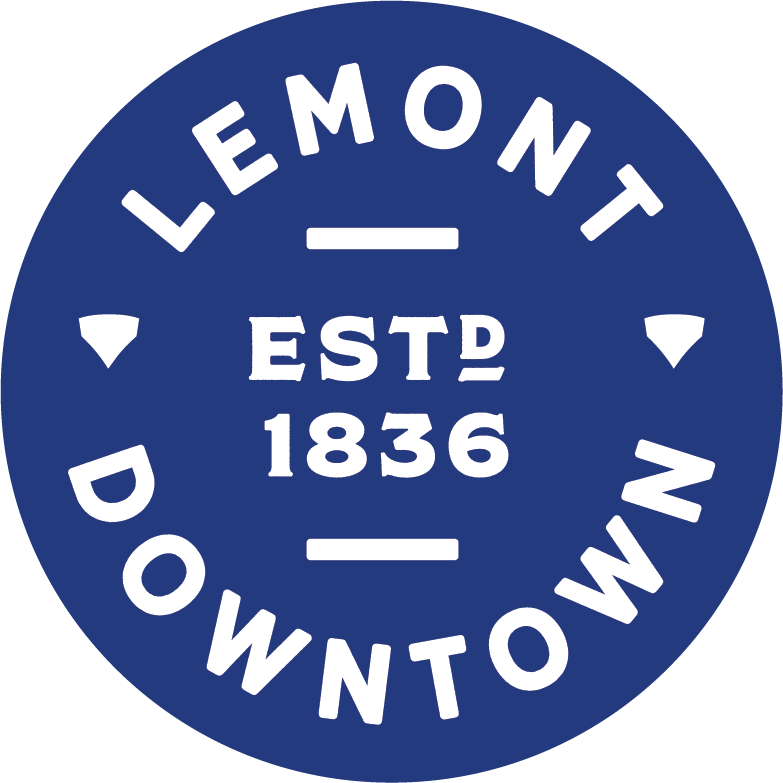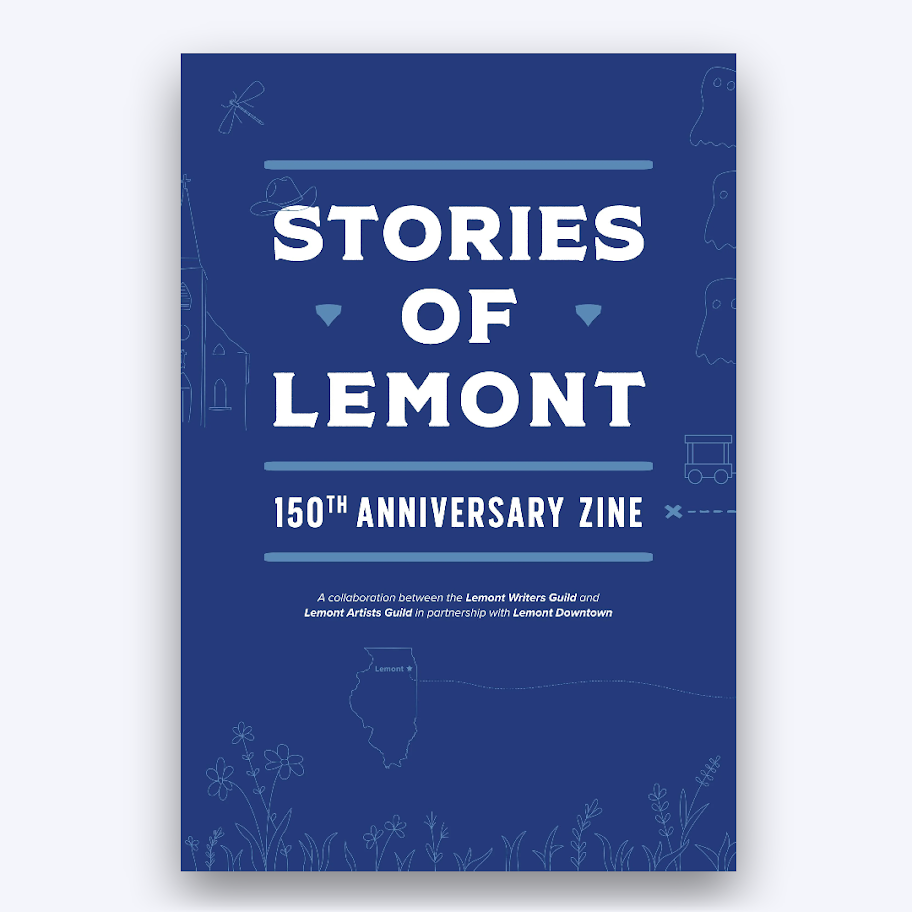Meet the Team behind the 150th Lemont Zine
Lemont is full of stories – our origin, the immigrants who built the village, and the millions of residents who have called it home in the last 150 years. If you stop a long-time Lemonter on the street or stop into any of the locally-owned small businesses that have been around for decades – Smokey Row, Nick’s Tavern, Hughie McLafferty’s or Tom’s Place – you’re bound to hear a few tales of folklore and legend.
In honor of our legacy, the Village of Lemont commissioned three organizations that are typically seen as the keepers and passers of stories in any society: Lemont Artists Guild, Lemont Writers Guild, and the Arts and Culture Commission of Lemont. Members of the guilds include hobbyists and professionals who are passionate about sharing their talents with others and creating in the community.
With their hard work, dedication, and support, we created Stories of Lemont: The 150th Anniversary Zine, a homage to the essence of Lemont with stories and imagery that honor past experiences, early founders, and influential characters throughout time. In advance of the March 15 Zine Release Party, we sat down with Nancy Uznanski, liaison for the Lemont Writers Guild, and Liz Connelly, President of the Lemont Artists Guild, to share more about the process and how Stories of Lemont: The 150th Anniversary Zine came to be.
TF: Liz, can you discuss the creative process behind translating written stories into visual art pieces? Were there specific challenges or inspirations?
LC: There are several steps to translate a written story into a visual art piece. The first step is to read through the story and make a few notes about the content of the story. Then, the artist can pick out some key ideas from these notes and consider what imagery comes to mind about these key ideas. The artist can then narrow down what imagery they can convey best by making some sketches of the imagery. The artist may need to do some research and find some pictures to help them create their imagery. Finally, the sketches that the artist feels are strongest and represent the story to pull the viewer’s eye into reading the story are what goes into the final art piece.
In the story, that I made an art piece for called “Fictional Letters to Mrs. Virginia Reed,” the letters are suggested fictional “thank-you” notes to Virginia Reed about a park that she established in Lemont. The letters mention landmarks in the park including a play train, elephant slide, teeter-totter, new rubber flooring, and “storytime” hill. I knew I could not illustrate all that was mentioned so I picked out what images I thought I could illustrate best. Since the story was specifically letters to Mrs. Virgina Reed about the park, I also included an illustration of notebook paper with handwriting quoting the parts of the letters about the landmarks in the park that I drew.
TF: Were there any unique techniques or mediums used by the artists to evoke the historical aspects of Lemont in their pieces?
LC: One unique element is having several images from different parts of the story composed together into the final piece. It takes time to consider how to juxtapose the images and successfully render them to be cohesive. Other techniques that show up are beautiful linework and blending of colors to show the historic quarry rock for which Lemont is so well known. All of the artists incorporated a variety of materials to create their art pieces including pen and ink, graphite and colored pencil, pastel, watercolor, collage, and photography.
TF: What should someone know if they are a local writer/artist and interested in getting involved with the Artists Guild?
LC: Established in 1992, the Lemont Artists Guild’s mission is to enhance life in Lemont and the surrounding community by providing fine art, education, instruction, programming, and appreciation through a supportive environment that nurtures creativity and individuality. We welcome artists of all kinds and art appreciators as well. We meet on the 2nd Wed. of the month (unless otherwise noted*) in conjunction with the Homer Township Public Library where we have a program on a topic of art. Confirmed dates are posted on our website and through the Homer Library's website. We also have other events throughout the year including plein air meet-ups in the summer, studio time meet-ups from September through May, and other events as noted on our website, sometimes including a member gallery exhibit. We are always looking for interested people who can enjoy sharing their talents with us!
Learn more about us at www.lemontartistsguild.org.
TF: Nancy, can you share insights into the creative process behind writing stories for the zine? What inspired you to write “A Glimpse of Historic Charm“?
NU: When the Lemont Writers Guild (LWG) and the Lemont Artists Guild (LAG) were offered the opportunity to work together by creating a special keepsake ‘zine’ as part of Lemont’s 150th Anniversary celebration it sounded like an opportunity we couldn’t pass up.
Once we agreed to participate, several of us quickly gravitated toward developing a memoir or historical piece while others were attracted to writing short stories. Choosing to write fiction or nonfiction also came fairly easily to most. Then, of course, we had to pick the subjects and write our stories within the word limit.
For me, when asked to consider writing about Lemont, my thoughts immediately went back to my first impression and how it is related to my relationship with the village. My family drove in from the north side on Lemont Road, the way the road was before the current bridge was built. We were heading south during the golden hours of a hot, sticky day in late September or early October, a little before the sun was ready to set. That particular view still stands out for me even today. In my writing, sharing that experience and its impact on me became my goal.
TF: Were there any challenges the writers faced in connecting their stories to Lemont's history while keeping them original and engaging?
NU: It turned out that all of us, who wrote for the zine, have lived in Lemont. I think that made the pieces easier to write. We found each others’ ideas interesting, and each story is set in the village at some time in its history. Our major challenges were deciding the specifics of what to write about and how to keep our work engaging for readers while staying within our word limit and time constraints.
Something I found interesting is that all of us ended up needing to research a little history about changes in the village since our associations with it began. A reminder of when a road changed, when an event began or stopped happening, the height of the water in the I&M canal, even when buildings and parks were constructed, removed, or changed, jogged memories. A couple of writers went the paranormal route, even reviewing local phenomena passed down in stories and reports.
TF: How did the collaboration work within the Writers Guild during the creation of the zine? Did members bounce ideas off each other or work individually?
NU: While a couple had no trouble deciding on their direction, most of us needed to bounce ideas off each other!
Of course, we all write because we are drawn to it, and our members have a wide range of interests and styles. So when all was finished, we had a nice variety that included: magical realism, historical adventure fiction, personal narrative, and memoir.
With the time frame, it was easier to meet deadlines by meeting online. Work was formatted and sent to everyone before each meeting, so comments and suggestions could be written on the formatted pages beforehand. During our live critiques, we were able to clarify thoughts, discuss any additional ideas, and help each other more fully. Figuring out how to create something intriguing and enjoyable for our readers, while keeping it very short, made critiques from our other writers extremely valuable.
TF: How did you like your sneak peek at the final product?
NU: I was pleasantly surprised at the size of the zine when I saw it. It is larger than the 5x7 size we expected. The finished product also turned out to have a nice vintage feel to it, which makes it reminiscent of earlier times and seems fitting for 150 years of history.
TF: What should someone know if they are a local writer and interested in getting involved with the Writers Guild?
NU: We welcome new writers anytime. Our in-person meetings are from 6:30 to 8:30 p.m., the first Monday of the month, in the Learning Center at the Lemont Public Library, 50 E. Wend Street.
The Lemont Writers Guild was started as the Lemont Writers Club, in 1989 by Mary Inman, who was the Lemont Library Children’s Librarian for more than 30 years. Our members enjoy trying different genres from fiction to nonfiction, poetry to prose, and fantasy to memoirs. We write to entertain, to inform, to publish, and just for the love of writing.
In addition, we offer a Writer’s Open Studio ‘body-doubling’ digital meet-up on the other Monday nights. These are meant to encourage writers to let go of all the nagging tasks they feel compelled to do, and just write. In practice, we normally join the group, say “Hi,” and then mostly ignore each other for a couple of hours while we remain online and work on our own writing projects.
You can check us out at lemontwriters.com and contact us through our website’s contact page. Or, come to a meeting. Our next few in-person meetings are on the Monday evenings of March 4th, April 1, and May 6, at Lemont Library. We hope to see you there.
The 150th Anniversary Zine is dedicated to Lemont, its history, and the writers and artists who have celebrated it through their work. To grab a limited edition copy of the Lemont: The 150th Anniversary Zine stop by the Zine Release party on Friday, March 15 from 6-8 pm at The Table! With a $5 cash donation, visitors receive a copy of the limited edition Zine - the first 10 people to donate receive a copy signed by the contributors! Attendees will view art from the Zine, hear from the writers about what inspired their Lemont stories, and enjoy light food and drink.




